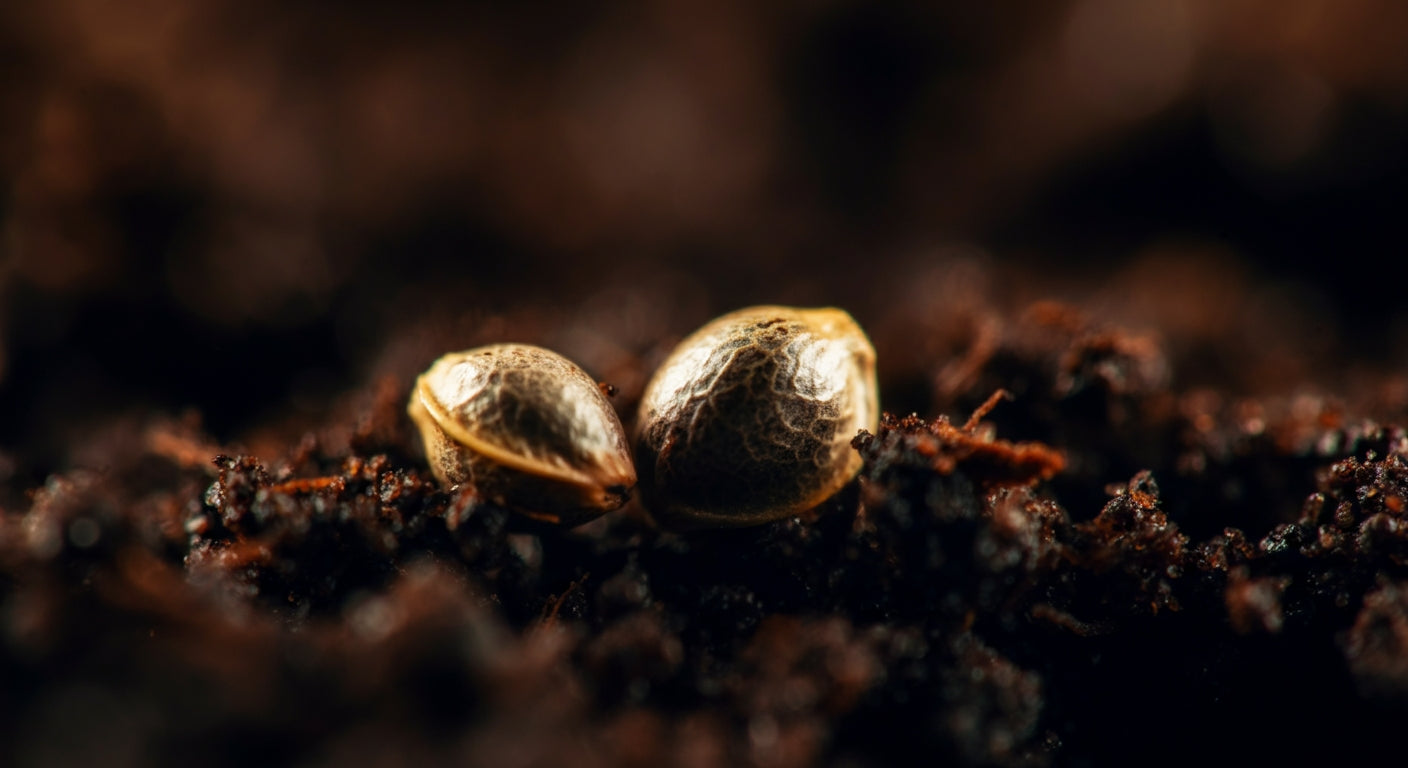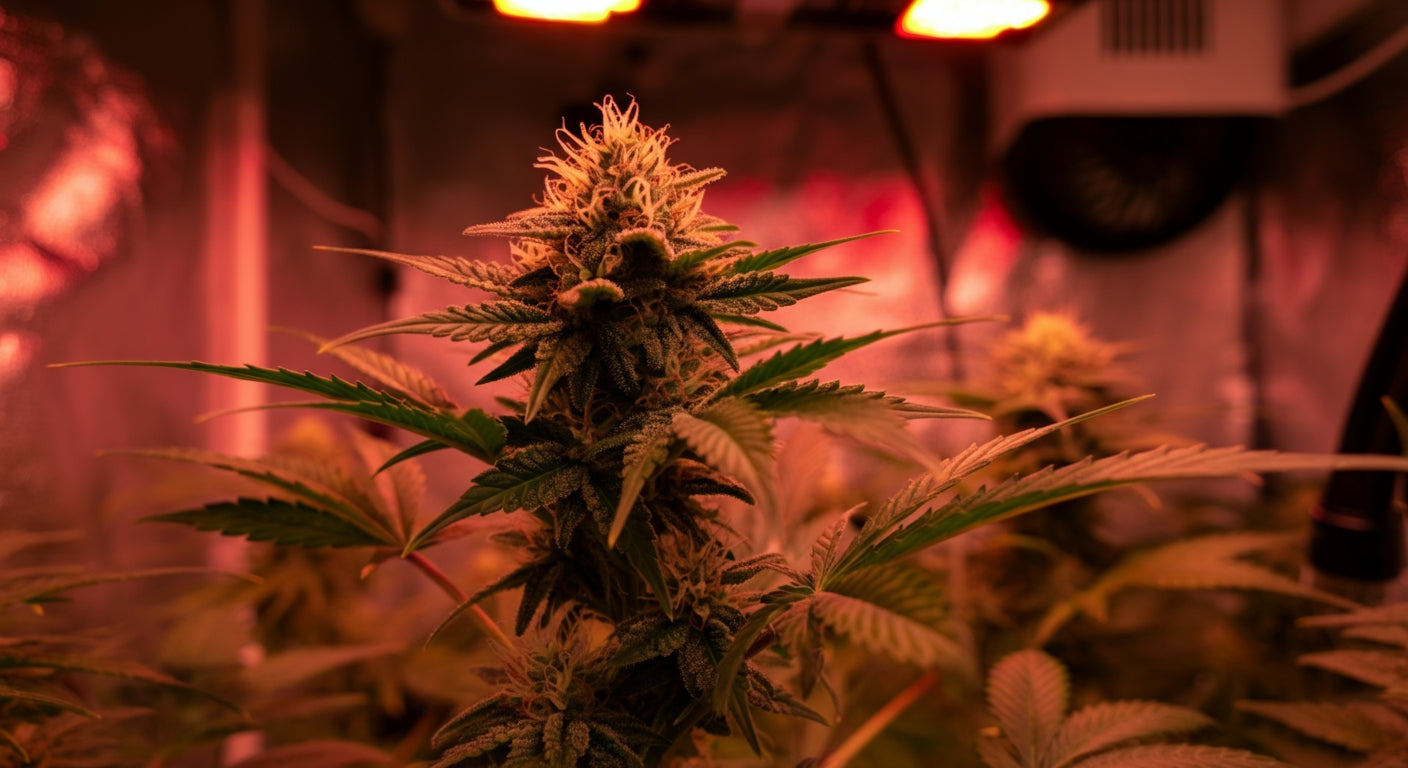
How to Grow Weed Seeds: Your Complete Guide to Cannabis Germination and Early Growth
Growing weed seeds successfully requires understanding the critical germination phase and early seedling development that sets the foundation for your entire cannabis grow. This delicate stage transforms dormant seeds into vigorous young plants, making proper techniques essential for achieving high germination rates and healthy seedling establishment.
Cannabis seeds represent the genetic potential of your future harvest, making the germination process one of the most crucial steps in cultivation. Mastering seed starting techniques ensures you maximize your success rate while developing strong, healthy plants from the very beginning.
Whether you're starting with premium genetics or working with older seeds, this comprehensive guide covers everything needed to successfully germinate cannabis seeds and nurture them through the critical early growth phases.
Understanding Cannabis Seeds and Genetics
Types of Cannabis Seeds
Different cannabis seed types require specific handling and growing approaches to achieve optimal germination and development results.
Regular Seeds: Produce both male and female plants in approximately equal ratios
- Advantages: Natural genetics, breeding potential, often more robust
- Considerations: Require sexing and male removal during early flowering
- Best For: Experienced growers interested in breeding or traditional cultivation
Feminized Seeds: Genetically modified to produce only female plants
- Advantages: Eliminate need for sexing, maximize space efficiency
- Considerations: Slightly more sensitive to stress than regular seeds
- Best For: Growers focused solely on bud production
Autoflowering Seeds: Automatically transition to flowering based on age
- Advantages: No photoperiod control required, faster harvest cycles
- Considerations: Cannot be cloned, generally smaller yields
- Best For: Beginners or growers wanting simple, quick harvests
Evaluating Seed Quality
High-quality seeds dramatically improve germination success rates and seedling vigor, making proper seed selection crucial for growing success.
Visual Quality Indicators:
- Color: Dark brown to black with smooth, waxy appearance
- Size: Plump, full seeds indicate mature genetics
- Shell: Hard, intact shell without cracks or damage
- Pattern: Tiger stripes or marbling often indicates quality genetics
Testing Seed Viability:
- Float Test: Viable seeds sink in water, while poor seeds float
- Physical Examination: Firm, undamaged shells suggest viability
- Source Reputation: Purchase from established, reputable seed banks
- Storage History: Properly stored seeds maintain viability longer

How to Germinate Seeds Successfully
Successful cannabis seed germination requires precise environmental conditions and proven techniques that maximize sprouting rates while minimizing stress.
Paper Towel Germination Method
The paper towel method remains the most popular and effective technique for cannabis seed germination due to its simplicity and high success rates.
Materials Needed:
- Clean paper towels or coffee filters
- Distilled or pH-adjusted water
- Dinner plates or shallow containers
- Plastic bags or plastic wrap
- Heat mat (optional but recommended)
Step-by-Step Process:
- Prepare Materials: Moisten paper towels with distilled water until damp but not dripping
- Place Seeds: Position seeds between moist towel layers, spacing them apart
- Create Environment: Place setup between two plates or cover with plastic wrap
- Provide Heat: Maintain 70-80°F (21-27°C) using heat mat if necessary
- Monitor Progress: Check daily for taproot emergence (usually 24-72 hours)
Paper Towel Method Benefits:
- Visual Monitoring: Easy to check germination progress without disturbance
- High Success Rates: Optimal moisture and temperature control
- Quick Results: Most seeds germinate within 1-3 days
- Quality Assessment: Identify non-viable seeds before planting
Direct Soil Germination
Direct soil germination offers advantages for growers who prefer minimal handling and natural growing conditions from the start.
Soil Germination Advantages:
- Reduced Transplant Shock: Seeds develop in final growing medium
- Natural Environment: Mimics outdoor germination conditions
- Root Protection: Delicate taproots avoid handling damage
- Simplified Process: One-step germination and planting
Direct Soil Technique:
- Prepare Medium: Use light, well-draining seed starting mix
- Create Holes: Make 0.5-inch deep planting holes
- Plant Seeds: Place seeds pointed-end down, cover lightly
- Maintain Moisture: Keep soil consistently moist but not waterlogged
- Provide Warmth: Maintain 75-80°F (24-27°C) soil temperature
Advanced Germination Methods
Experienced growers can utilize specialized techniques for challenging seeds or optimal results.
Rockwool Germination: Perfect for hydroponic growing systems
- Preparation: Soak rockwool cubes in pH 5.5 water
- Placement: Insert pre-germinated seeds or direct sow
- Environment: Maintain high humidity dome conditions
- Benefits: Seamless transition to hydroponic systems
Scarification Method: For older or hard-shelled seeds
- Technique: Lightly sand seed shell to improve water uptake
- Caution: Avoid damage to inner seed contents
- Application: Use only on seeds with germination issues
Creating Optimal Germination Environments
Environmental Requirements for Seed Sprouting
Cannabis seeds require specific environmental conditions to achieve maximum germination rates and healthy seedling development.
Temperature Requirements:
- Optimal Range: 70-85°F (21-29°C) for fastest germination
- Consistency: Avoid temperature fluctuations that stress seeds
- Heat Sources: Use seedling heat mats for consistent warmth
- Monitoring: Check temperatures regularly with accurate thermometers
Humidity and Moisture Management:
- Germination Humidity: 70-90% relative humidity for optimal sprouting
- Moisture Balance: Keep growing medium consistently moist, never soaked
- Air Circulation: Gentle airflow prevents fungal issues
- Humidity Domes: Use clear covers to maintain optimal moisture levels
Lighting Considerations:
- Germination Phase: Complete darkness promotes initial sprouting
- Seedling Emergence: Gentle light once cotyledons appear
- Light Intensity: 200-400 PPFD for newly emerged seedlings
- Photoperiod: 18-24 hours of light for vegetative development
Equipment for Successful Seed Starting
Proper equipment significantly improves germination success rates and seedling health during the critical early development phase.
Essential Germination Equipment:
- Seedling Heat Mats: Maintain consistent soil temperatures
- Humidity Domes: Create optimal moisture conditions
- pH Meters: Monitor water and soil pH levels
- Thermometers: Track temperature consistency
- Gentle Lighting: LED grow lights for seedling development
Growing Medium Selection:
- Seed Starting Mix: Light, well-draining commercial blends
- Peat Pellets: Convenient individual growing containers
- Rockwool Cubes: Ideal for hydroponic transitions
- Organic Soil: Light, amended potting soils for natural growing
Early Seedling Care and Development
First Week After Germination
The first week after germination is critical for establishing healthy seedlings that will develop into vigorous plants.
Cotyledon Stage (Days 1-7):
- Light Requirements: Gentle lighting 18-24 hours daily
- Watering: Light misting to maintain soil moisture
- Temperature: 75-80°F (24-27°C) for optimal development
- Humidity: 65-75% relative humidity supports leaf development
Key Development Milestones:
- Day 1-2: Cotyledon leaves emerge and unfold
- Day 3-5: Stem elongates and strengthens
- Day 5-7: First true leaves begin developing
- Environmental Adjustment: Gradually reduce humidity as plants strengthen
Transitioning to Vegetative Growth
Successfully transitioning seedlings from germination to vegetative growth requires gradual environmental adjustments and proper care techniques.
Environmental Transition:
- Light Intensity: Gradually increase to 400-600 PPFD
- Humidity Reduction: Lower to 60-70% relative humidity
- Air Movement: Introduce gentle air circulation
- Temperature Stability: Maintain consistent 75-80°F (24-27°C)
Feeding Young Seedlings:
- Initial Nutrition: Cotyledons provide nutrients for first 1-2 weeks
- First Feeding: Very light nutrient solution (25% strength) after true leaves appear
- pH Management: Maintain 6.0-6.5 pH for optimal nutrient uptake
- Gradual Increase: Slowly increase feeding strength as plants grow

Transplanting and Continued Growth
When and How to Transplant
Proper transplanting techniques ensure seedlings continue growing vigorously without experiencing shock or setbacks.
Transplant Timing Indicators:
- Root Development: Roots visible through drainage holes
- Size Criteria: 2-3 sets of true leaves fully developed
- Container Outgrowth: Plants appear too large for current containers
- Age Factor: Generally 2-4 weeks after germination
Transplanting Technique:
- Timing: Transplant just before lights turn on
- Medium Preparation: Pre-moisten new growing medium
- Gentle Handling: Minimize root disturbance during transfer
- Initial Care: Provide gentle lighting and avoid feeding for 24-48 hours
Setting Up Growing Environments
Transitioning seedlings to larger growing environments requires proper equipment and environmental management for continued success.
Best Grow Tent Setup for Beginners becomes crucial as seedlings outgrow their starting containers and need proper growing environments.
Growing Environment Requirements:
- Space Planning: 2x2 or 3x3 grow tents perfect for seedling development
- Lighting Systems: Xi LED grow lights provide optimal spectrum for continued growth
- Environmental Control: Proper ventilation and climate management
- Future Planning: Consider mature plant size when selecting equipment
Troubleshooting Germination Issues
Common Germination Problems
Understanding and addressing common germination failures improves success rates and reduces frustration with challenging seeds.
Low Germination Rates:
- Causes: Old seeds, poor storage, inadequate moisture, wrong temperature
- Solutions: Use fresh seeds, improve environmental conditions, try scarification
- Prevention: Source quality seeds from reputable suppliers
Slow Germination:
- Causes: Cool temperatures, hard seed shells, insufficient moisture
- Solutions: Increase temperature, extend germination period, check moisture levels
- Patience: Some genetics naturally germinate slower than others
Seedling Damping Off:
- Causes: Fungal infections from overwatering or poor air circulation
- Prevention: Avoid overwatering, provide air movement, use sterile growing medium
- Treatment: Remove affected seedlings, improve environmental conditions
Improving Success Rates
Implementing proven strategies maximizes germination success while minimizing common problems that plague beginning growers.
Quality Control Measures:
- Seed Source: Purchase from established, reputable seed banks
- Storage Conditions: Keep seeds cool, dry, and dark until use
- Water Quality: Use distilled or filtered water for germination
- Sterile Conditions: Use clean equipment and sterile growing mediums
Environmental Optimization:
- Temperature Consistency: Use heat mats for stable temperatures
- Humidity Management: Maintain optimal moisture without overwatering
- Air Quality: Provide gentle air circulation to prevent fungal issues
- Monitoring: Check conditions daily and adjust as needed
Advanced Seed Starting Techniques
Hydroponic Seed Starting
Hydroponic growing systems offer advantages for seed starting when properly implemented with appropriate techniques.
Hydroponic Germination Benefits:
- Faster Development: Optimal nutrition accelerates early growth
- Root Health: Excellent oxygenation promotes robust root systems
- Disease Prevention: Sterile growing medium reduces pathogen risks
- Seamless Transition: No transplant shock when moving to larger systems
Hydroponic Seed Starting Methods:
- Rockwool Cubes: Standard method for hydroponic germination
- Rapid Rooter Plugs: Organic alternative to rockwool
- Starter Plugs: Various commercial options for easy germination
- Deep Water Culture: Direct germination in hydroponic systems
Automated Seed Starting Systems
Modern technology enables automated seed starting systems that improve consistency while reducing daily maintenance requirements.
Automation Benefits:
- Consistent Conditions: Automated environmental control
- Reduced Labor: Less daily monitoring and adjustment
- Better Results: Optimal conditions maintained continuously
- Scalability: Easy to manage larger numbers of seeds
Automated Growing Systems can handle seed starting through complete plant development with minimal intervention.
Strain-Specific Considerations
Different Genetics, Different Needs
Various cannabis genetics have different germination characteristics and seedling requirements that affect growing approaches.
Indica vs. Sativa Germination:
- Indica Strains: Generally faster germination, compact seedling growth
- Sativa Strains: May take longer to germinate, more elongated seedlings
- Hybrid Varieties: Characteristics depend on dominant genetics
Autoflower Seed Considerations:
- Genetic Clock: Begin aging immediately upon germination
- Stress Sensitivity: Less tolerant of transplant shock or environmental stress
- Time Limitations: Cannot extend vegetative period to recover from problems
- Direct Planting: Often better to germinate in final containers
Landrace vs. Hybrid Seeds
Different cannabis genetic backgrounds require adjusted approaches for optimal germination and early development.
Landrace Considerations:
- Hardier Genetics: Often more resistant to environmental stress
- Slower Development: May take longer to germinate and establish
- Traditional Methods: Often respond well to simple, natural approaches
Modern Hybrid Benefits:
- Improved Vigor: Hybrid vigor often improves germination rates
- Predictable Characteristics: More consistent germination timing
- Adaptation: Bred for indoor growing conditions

Scaling Seed Operations
Managing Multiple Seeds
Growing multiple seeds simultaneously requires organization and systems to ensure consistent results across all seeds.
Batch Processing:
- Timing Coordination: Start all seeds simultaneously for uniform development
- Environmental Consistency: Maintain identical conditions for all seeds
- Individual Monitoring: Track each seed's progress separately
- Quality Control: Remove weak or problematic seedlings early
Record Keeping:
- Germination Rates: Track success rates by strain and technique
- Development Timing: Note germination and growth milestones
- Environmental Data: Record temperature, humidity, and other conditions
- Strain Performance: Identify best-performing genetics and methods
Equipment Scaling
Larger seed operations require scaled equipment and systems to maintain quality while increasing capacity.
Scaling Considerations:
- Heat Mat Capacity: Ensure adequate heating for all seed containers
- Lighting Systems: Scale lighting to cover all seedling areas
- Humidity Control: Maintain optimal conditions across larger areas
- Workspace Organization: Efficient layout for managing multiple seeds
Legal and Safety Considerations
Compliance with Local Laws
Always ensure seed acquisition and germination comply with local cannabis cultivation laws and regulations.
Legal Considerations:
- Source Verification: Purchase seeds from legal, licensed sources
- Plant Count Limits: Stay within legal limits from germination onward
- Documentation: Maintain records as required by local regulations
- Age Requirements: Ensure compliance with minimum age requirements
Safe Practices
Implement safe practices when handling seeds and growing equipment to protect both plants and growers.
Safety Measures:
- Electrical Safety: Use GFCI protection for all electrical equipment
- Chemical Handling: Store and use germination aids safely
- Sanitation: Maintain clean conditions to prevent contamination
- Equipment Safety: Follow manufacturer guidelines for all equipment
FAQ Section
How long do cannabis seeds take to germinate?
Most cannabis seeds germinate within 24-72 hours under optimal conditions (70-80°F, high humidity). Some seeds may take up to 5-7 days, while old or poor-quality seeds might not germinate at all.
What's the best temperature for germinating weed seeds?
The optimal temperature range for cannabis seed germination is 70-85°F (21-29°C), with 75-80°F (24-27°C) being ideal. Seedling heat mats help maintain consistent temperatures.
Can I plant seeds directly in soil instead of paper towels?
Yes, direct soil planting works well and reduces transplant shock. Use light, well-draining seed starting mix and maintain consistent moisture and temperature for best results.
Why are my cannabis seeds not germinating?
Common causes include old seeds, improper storage, incorrect temperature/humidity, overwatering, or poor-quality seeds. Try using fresh seeds with proven germination techniques and optimal environmental conditions.
When should I transplant cannabis seedlings?
Transplant when seedlings have 2-3 sets of true leaves and roots are visible through drainage holes, typically 2-4 weeks after germination. Handle gently and avoid disturbing roots unnecessarily.
Summary
Bottom Line: Successfully growing weed seeds requires understanding proper germination techniques, maintaining optimal environmental conditions, and providing appropriate early care to establish healthy seedlings that develop into vigorous plants.
Seed germination represents the foundation of successful cannabis cultivation, making mastery of these techniques essential for consistent growing success. Quality seeds combined with proven methods ensure maximum germination rates and healthy plant development from the very beginning.
Start Your Cannabis Growing Journey with Perfect Seeds
Transform premium cannabis genetics into thriving plants with equipment designed for optimal seed germination and seedling development. Gorilla Grow Tent provides everything necessary for successful seed starting, from controlled germination environments to gentle LED lighting systems perfect for seedling development.
Whether you're starting with beginner-friendly grow tent kits or building advanced hydroponic germination systems, our equipment ensures optimal conditions for every stage of seed development. With professional environmental control, quality growing mediums, and lifetime growing support, you'll achieve consistently high germination rates and healthy seedling establishment.
Don't let poor germination rates limit your growing success. Browse our complete selection of seed starting equipment and automated growing systems to build the perfect setup for transforming seeds into exceptional plants. Join thousands of successful growers who trust Gorilla for consistently outstanding germination results and healthy seedling development, grow after grow.

Lena Myles
I'm a mushroom enthusiast and home cook based in Oregon. I'm passionate about foraging and creating fungi-focused recipes, especially delicious, plant-based dishes using gourmet mushrooms like trumpet, shiitake, and oyster. When I’m not in the kitchen, you’ll usually find me wandering the woods in search of new wild flavors.


